by Ray Bodrey | May 4, 2018
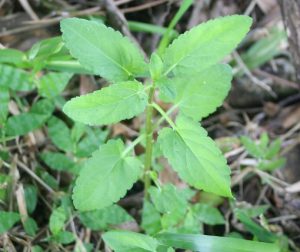
Figure 1: Florida Betony, Stachys floridana. Credit: UF/IFAS Range Cattle Research & Education Center.
If you look closely at your yard, there is a good chance that you will find a plant that, depending on who you ask, is considered either a native wildflower or a weed and there are more than a few species that fit this description. If, upon even closer inspection, you find a plant with root tubers that resemble egg casings or even a rattlesnake’s rattle, you’ve stumbled upon Florida Betony.
Stachys floridana is a perennial broadleaf commonly referred to as rattlesnake weed due to it’s fleshy, white, segmented underground tubers. The plant has an erect stem with leaves that are opposite, shovel-shaped and coarsely serrated. The plant structure is very similar to mint. Flowers, emerging in late spring, are pinkish-purple in color. These inflorescences will also produce fruit, consisting of four nutlets. However, reproduction of the plant and it’s propensity to spread through lawns and gardens primarily occurs through dense root tuber development. Florida Betony’s growing range was originally confined to the state of Florida, but the commercial nursery trade played a major hand in dispersing the plant across the Southeast in the mid-1900’s. It can now be found as far west as Texas and as far north as North Carolina.

Figure 2: Tubers of the Florida Betony. Credit: Jill Bebee, UF/IFAS Gulf County Master Gardener.It can now be found as far west as Texas and as far north as North Carolina.
This time of year is when Florida Betony thrives. The moderate temperatures of fall and spring are the prime growing periods for Betony. In the heat of the summer, the above-ground structure of the plant will struggle and often disappear completely, only to reemerge in the fall. As a lawn weed, managing tuber development is key to controlling this plant. Applying herbicide to the leaves and stalk may seem at first to have conquered the weed. However, in most cases the tuber will simply regenerate. Glyphosate (Roundup) can be used effectively for control in ornamental plant beds where no turf is present. Be careful when spraying herbicides around trees, shrubs and other desirable plants as any foliar contact will cause phytotoxicity. If you have an infestation of Florida Betony in your turfed areas, there are a few options for control. Regular applications of three way broadleaf herbicides, such as mixtures of 2-4D, Dicamba and Mecoprop, are effective at suppressing this pesky plant. For more information and options, please contact your local county extension office or see the supporting information links below. Always refer to the product label for specific uses, precautions and application rates when using any herbicide.
Supporting information for this article can be found in the following the UF/IFAS EDIS publication, “Florida Betony Biology and Management in Turf” by J. Bryan Unruh, Ramon G. Leon, and Darcy E. P. Telenko: http://edis.ifas.ufl.edu/pdffiles/EP/EP38800.pdf
by Matt Lollar | Apr 13, 2017
Most of you plant a spring vegetable garden with a number of different vegetable types. However, you may not realize that you are improving the health of your soil and your crops by planting a diverse garden. Intercropping is a gardening practice of growing different crops in the same field. When planting a mixture of crops in the same field year after year, it is important to rotate the location of each type of vegetable. This is a practice known as crop rotation. Intercropping and crop rotation will help reduce insect pest populations, increase beneficial insect populations, and reduce weed populations.
Crop Diversity
Growing plants in your garden that pest insects don’t like to eat makes the pests work harder to find what they do like to eat. Studies have found reduced whitefly numbers on squash plantings mixed with a crop of buckwheat when compared to squash planted alone. Another crop mixture that may be unintentional, but may work in your favor is a row of crapemyrtles along the edge of your garden. Crapemyrtles will attract the crapemyrtle aphid which will attract predatory insects. When the predatory insects run out of crapemyrtle aphids to eat, they will move to your garden and begin to hunt pest insects on your vegetable crop.

Squash with living mulch of buckwheat. Photo Credit: Oscar Liburd, UF/IFAS Extension
Trap Cropping
A trap crop is a plant that attracts a pest insect away from your food crops. Trap crops work best when planted at the edge of your garden, along a fence row, or in movable containers. A bare space, let’s say 5 feet or so, should be kept between your trap crop and your garden. This will help keep the pests from moving on to your vegetables. When you find a good population of pests on your trap crop then it is time to spray them with insecticide or cut the crop down and remove the debris to a location far from your garden. If your trap crops are planted in containers, then it makes them that much easier to remove from near the garden area.
Cover Crops and Green Manure
Soil organic matter can be increased by the use of green manure and cover crops. Cover crops are generally planted during the off-season, but they can be planted in between vegetable rows and tilled in at a designated time as a green manure. Both cover crops and green manure improve the production of your garden by:
- Suppressing weeds by competing for water, light, and nutrients;
- Holding the soil in place and preventing erosion;
- Scavenging for nutrients that can be utilized in future crops;
- Reducing nematode populations;
- Providing a habitat for beneficial insects.
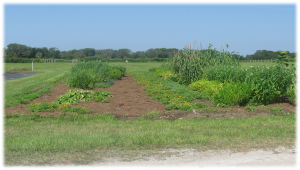
A mixed plot of cover crops and trap crops. Photo Credit: UF/IFAS Extension
A number of different crops can serve as cover crops or green manure crops. Most are legumes (bean family) or grasses. A few that you might like to give a try are:
- Cowpeas
- Sunn hemp
- Sorghum-sudangrass
- Winter rye
More detailed information on cover crops and green manure can be found at this link: http://edis.ifas.ufl.edu/aa217.
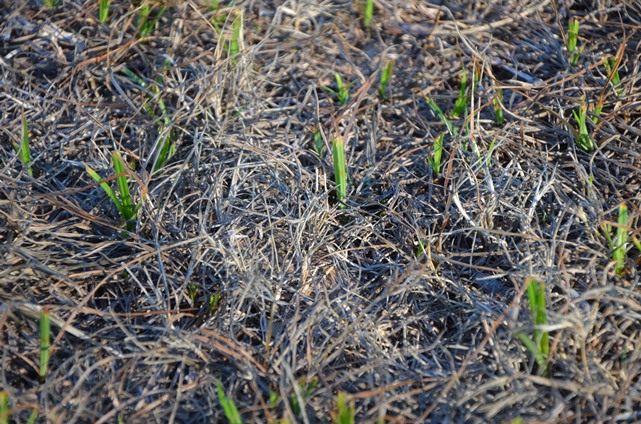
by Les Harrison | Mar 2, 2017
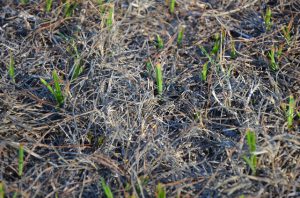
Photo caption: Purple nut sedge is dormant, but quite alive and waiting for warm weather. The best hope for control is to use a pre-emergent herbicide in late February to early March which will prevent this exotic invasive plant from germinating.
Now that March is here the lawn becomes less of an abstraction and more reality.
The lawnmower is no longer silent, meaninglessly taking up space as the grass wakens from its seasonal stupor. Alas, the dormant state has ended as the days are already getting slightly longer.
There is still time to get started with preparations for the ideal spring lawn of 2017. Weather is getting warmer, there is plenty to do.
In addition to doing a soil test, mentioned in previous week’s articles, an accurate weed assessment is also necessary. Though not green and conquering new territory, some of the weeds remain with seed still attached and awaiting distribution.
If the seed are still on the plants, clip the seed pods or remove the plants with the seed intact. Dispose of these properly and do not give them a chance to spread and germinate.
Two notable culprits are nondescript lying dormant waiting for the return of warm, sunny weather. Purple nut sedge and chamberbitter still have countless nutlets and seeds connected to the parent plant.
Purple nut sedge, Cyperus rotundus, grows from every possible sunny location with soil. This non-native plant is a rapidly spreading perennial which will take every opportunity to colonize new locations.
The identifier purple is in its name because there is a purple-tinged section of this sedge where it emerges from the ground. The plant is sometimes referred to as purple nut grass because of its long narrow leaves and its erect growth pattern originating from a nutlike basal bulb.
Chamberbitter, Phyllantus urinaria, is an annual with produces great quantities of seed on the underside of its leaf stems. It will handle full sun or partial shade and quickly form cluster of plants, each contribution seed to the soil.
Areas in the lawn identified as having severe infestations should be marked now for treatment in the near future with a pre-emergent herbicide. This type of herbicide prevents the seed from germinating in the spring.
Purple nut sedge concentrations should be sprayed in late February to early March, and chamberbitter in April since these pest species germinate at different times.
Another winter task is to prepare for seeding bare spots in the lawn. Reading the seed tag attached to the bag should help make the product selection much easier.
Check to confirm the seed has been tested for germination within the year. Also, be sure the grass seed species will grow in Florida.
Sometime generic lawn seed mixes will contain fescue, bluegrass, orchard grass and others turf types which will not grow in north Florida. While they may germinate, their use will only ensure weeds get established for another year.
Lastly, sharpen the lawnmower blade. When the warm weather arrives the mower will be frequently used, but at least the neighbors will be envious of the great green lawn.

by Beth Bolles | Jan 17, 2017
It won’t be long before homeowners start thinking about sodding a new lawn or renovating areas of their existing turf. Although sodding when turf is dormant is acceptable, it is best to install sod that is green. One reason is that you can see if any sod pieces are infested with weeds such as bermudagrass . This perennial grass is very difficult to manage once it becomes established in centipede, St. Augustine, or zoysiagrass. Always remove turf pieces with bermudagrass during the installation process to prevent it from taking over a patch of your new lawn.
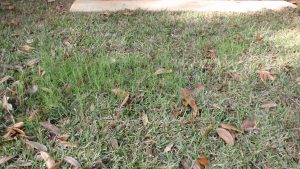
Bermudagrass growing in a piece of centipede sod. This piece should have been removed during installation to prevent the bermudagrass from taking over a patch of new centipede lawn. Photo by Beth Bolles, UFAS IFAS Escambia County Extension
If you have a piece of turf or a small area where common bermudagrass has emerged in your desirable grass, take care of the issue as soon as it is seen. The best option is dig out the infested area making sure that you get the underground runners of the bermudagrass. Smooth out the bare soil and then install new sod pieces. You may have to hand water these pieces as needed since the surrounding turf will already be established.
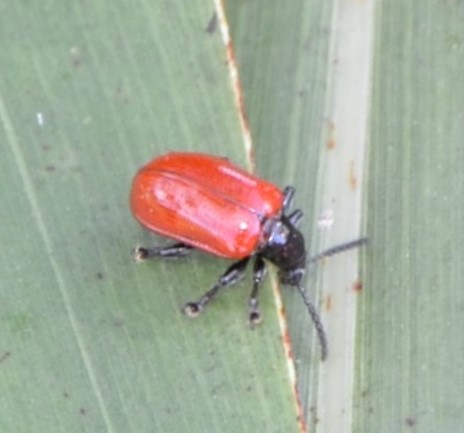
by Les Harrison | Aug 23, 2016
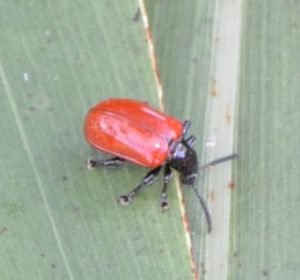
Air potato leaf beetle. Photo credit: Les Harrison, UF/IFAS.
A small, but brightly colored beetle has appeared in north Florida: the air potato leaf beetle (Liliocetis cheni), a native of East Asia. The beetle, less than half an inch long, has a candy apple red body that stands out against green leaves and the more muted earth tones of most other bugs. The striking bright glossy red coating would be the envy of any sports car owner or fire truck driver.
Unlike other arrivals to the U.S., this insect was deliberately released in 2012 for biological control of air potato. After years of testing, approval was finally given to release air potato leaf beetles to begin their foraging campaign against this invasive plant species. The beetle has very specific dietary requirements and only can complete its life cycle on air potato. The larvae and adults of this species consume the leaf tissue and occasionally feed on the tubers.
When a population of air potato leaf beetles finish off an air potato thicket, they go in search of nourishment from the next patch of air potato. They are sometimes seen during stopovers while in search of their next meal.
Air potato (Dioscorea bulbifera) is an herbaceous perennial vine which is easily capable of exceeding 60 feet in length. It quickly will climb over any plant, tree or structure unfortunate enough to be in its vicinity. The vine also produces copious quantities of potato-like tubers suspended from its vines. Unless collected and destroyed, most of the easily camouflaged potatoes will germinate and intensify the infestation.
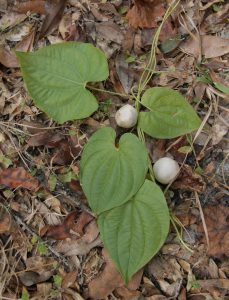
Air potato. UF/IFAS Photo: Thomas Wright.
Air potato came to Florida in 1905 from China and quickly escaped into the wild. By the 1980’s it was a serious pest species in south and central Florida, but has gradually become established in the panhandle, too. Chemical control of the air potato has been difficult. Repeated herbicide treatments are required to kill a thicket with multiple plants.
Unlike the air potato leaf beetle that only eats air potato, kudzu bugs eat their namesake vine (kudzu), but also feed on a number of other plants including a wide selection of valuable legumes and be quite destructive. Kudzu bugs were accidently introduced in north Georgia in 2009 and have spread across the south in the ensuing years and become established in north Florida.
It is a pleasant surprise to know air potato leaf beetles are working to limit the invasive air potato vine, but it is sad to think there is plenty more for them to eat.
To learn more about the air potato and the beetle:
Natural Area Weeds: Air Potato (Dioscorea bulbifera)
Air Potato Leaf Beetle Publication











